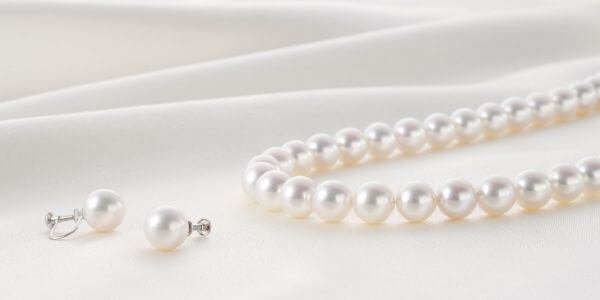Pearls have always been more than simple ornaments. They carry a certain mystery born inside living shells, shaped by patience, and polished by time. A pearl necklace holds meaning that goes far beyond elegance. It represents history, power, love, spirituality, and personal expression.
For centuries, the pearl necklace meaning has shifted across cultures and eras. Once reserved for kings and queens, pearls today are cherished by brides, gifted in milestones, and worn by celebrities. To understand why this gemstone has endured, you need to dive into its symbolic depth.
The Long History
Pearls are among the world’s oldest gemstones, admired for thousands of years.Their natural beauty made them symbols of rarity and perfection.
- Ancient Egypt: Pearls were buried with rulers as treasures for the afterlife. Cleopatra famously dissolved a pearl in wine to prove her wealth and seduction power.
- Rome: The Roman elite adored pearls. They passed laws restricting their use to the upper class, showcasing pearls as ultimate symbols of privilege.
- China: Pearls represented wisdom and spiritual protection. Ancient texts describe pearls as talismans against fire and misfortune.
- Medieval Europe: Monarchs decorated crowns and robes with pearls, associating them with purity and divine favor.
- Renaissance: Portraits of European queens show elaborate pearl necklaces, displaying aristocracy and wealth.
Historical Timeline of Pearl Necklace Symbolism
| Era / Region | Pearl Necklace Meaning | Example / Tradition |
| Ancient Egypt | Eternal wealth, immortality | Cleopatra’s pearl wine legend |
| Roman Empire | Social status, exclusivity | Laws restricting pearls to nobility |
| China | Wisdom, spiritual balance | Used as protective talismans |
| Medieval Europe | Purity, divine blessing | Pearls in coronation regalia |
| Renaissance Europe | Power, elegance, prestige | Elizabeth I’s pearl portraits |
Symbolism Across Cultures
Across the world, pearls have symbolized everything from purity to mystery. Each culture adds its own interpretation.
Eastern Perspectives
- China: Pearls symbolized long life and wisdom. Legends say they came from the brains of dragons, holding divine energy.
- India: Pearls were wedding blessings. Hindu texts connect pearls with prosperity, fertility, and marital harmony.
- Japan: In Shinto traditions, pearls represented purity of the soul. Cultured pearls, pioneered by Mikimoto in the 20th century, became a national symbol of pride.
Western Perspectives
- Europe: Pearls were a mark of nobility. Laws like “sumptuary codes” restricted pearls to the upper classes.
- Christianity: Pearls symbolized purity, often associated with Mary. The Bible’s “pearl of great price” refers to spiritual enlightenment.
- Victorian Era: Pearls carried dual symbolism. They were worn as bridal jewelry but also as mourning jewelry, seen as “tears frozen in stone.”
Spiritual and Emotion Meaning
Wearing pearls is not just about aesthetics. Many believe pearls carry spiritual and emotional power.
- Calming Energy: Pearls are thought to bring serenity, reduce stress, and encourage clarity.
- Feminine Symbolism: As gems of the moon, pearls embody intuition, fertility, and feminine wisdom.
- Transformation: Because pearls form around irritation inside oysters, they symbolize resilience, growth, and beauty through struggle.
- Protection: Cultures from Asia to the Middle East used pearls as amulets to ward off evil.
The pearl serves as the memoir of the oyster. – Federico Fellini
Modern Fashion
Pearls have gone from royal courts to global runways. They remain timeless yet adaptable.
- Elegance: A single strand of pearls is still the hallmark of refined style. Jackie Kennedy famously remarked, “Pearls are perpetually suitable.
- Rebellion: Modern stars wear pearls in unexpected ways. Harry Styles sports them with streetwear, redefining gender norms.
- Luxury Status: Fashion houses like Chanel and Dior showcase pearls as high-end staples.
- Cultural Symbolism: Kamala Harris wore pearls at her inauguration, honoring her sorority where pearls represent resilience and unity.
Case Study: Pearls in Pop Culture
When Rihanna wore layered pearl chokers at the Met Gala, it wasn’t just an accessory—it was a bold statement merging tradition with avant-garde fashion. Pearls are now both classic and edgy, depending on how you wear them.
Pearl Necklace Symbolism
Pearls make meaningful gifts because they carry layered symbolism.
Romantic Meaning
- Given as wedding or anniversary gifts.
- Represent eternal love and devotion.
- Frequently donned by brides as a representation of “something antique” or “something unblemished.”
Family Bonds
- Parents gift pearl necklaces to daughters for graduations or weddings.
- Symbol of legacy, values, and tradition passed down generations.
Friendship and Respect
- Symbolize trust, gratitude, and loyalty.
- Given in professional settings as marks of honor or respect.
Types and Their Meanings
Pearl color and style influence meaning just as much as culture.
| Pearl Type | Symbolism | Popular Use |
| White Pearls | Purity, innocence, timeless elegance | Weddings, formal events |
| Black Pearls | Mystery, independence, spiritual strength | Statement fashion, men’s jewelry |
| Pink Pearls | Compassion, love, tenderness | Romantic gifts |
| Golden Pearls | Wealth, prosperity, luck | Luxury wear |
| Baroque Pearls | Individuality, authenticity, uniqueness | Artistic and modern fashion |
Astrology and Birthstones
Astrology deepens pearl symbolism.
- Birthstone for June: Pearls bring peace, prosperity, and balance for June-borns.
- Zodiac Connections: Linked to Cancer, Pisces, and Gemini due to water symbolism.
- Astrological Use: Believers wear pearls to attract love, calm emotions, and strengthen intuition.
In Vedic astrology, the Moon is linked to pearls.Wearing a pearl necklace is believed to bring mental clarity and emotional stability.
Wearing Pearls with Intention
Choosing how to wear pearls can amplify their symbolic meaning.
- Set a Purpose: Select pearls for love, calmness, or prosperity.
- Style Tips:
- Layer pearls with chains for a modern twist.
- Wear chokers for bold looks.
- Use single strands for classic elegance.
- Spiritual Use: Some wear pearls during meditation or affirmations to channel peace.
Myths and Misconceptions
Like most gems, pearls carry myths.
- Bad Luck Belief: Some cultures view pearls as tears, unlucky when given as gifts. Others believe they symbolize resilience, making them lucky.
- Fake vs. Real: Cultured pearls, though farmed, hold equal symbolic power as natural pearls.
- Gender Bias: Pearls were once seen as feminine only. Today, pearls are proudly worn by men in fashion and music.
Why Pearl Necklace Meaning
The meaning of a pearl necklace has endured because it speaks across time. Pearls tell stories of resilience, purity, wealth, and love. They connect cultures and generations, carrying both personal and collective symbolism.
When you wear a pearl necklace, you don’t just wear jewelry. You wear history, tradition, and meaning. Pearls remind us that beauty can emerge from struggle, and that elegance is timeless.
FAQs
- What does a pearl necklace symbolize?
It represents purity, love, wisdom, and resilience. - What does it mean if someone gives you pearls?
It usually symbolizes affection, loyalty, or blessings for prosperity. - Are pearls good or bad luck?
Pearls were once linked with sorrow, but most cultures today see them as positive symbols. - What color pearl should I choose?
Choose white for purity, black for mystery, pink for romance, or golden for prosperity. - Do pearls have spiritual energy?
Many believe pearls balance emotions, protect from negativity, and promote clarity.
Final Word
The pearl necklace meaning spans centuries of culture, spirituality, and personal symbolism. From Cleopatra to modern fashion icons, pearls remain unmatched in their blend of beauty and meaning. Whether worn as a family heirloom, a romantic gift, or a statement of individuality, a pearl necklace continues to shine as one of the most powerful symbols in jewelry history.



